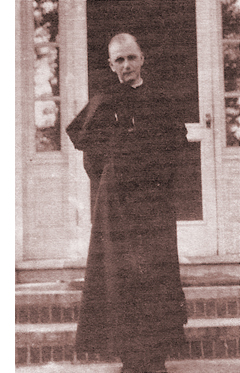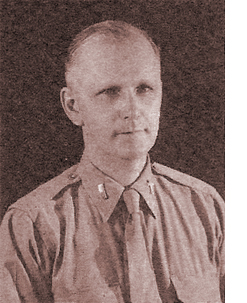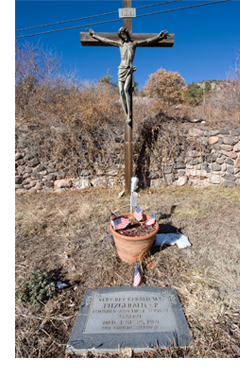The Story of Father Gerald Fitzgerald sP
In 1947 Father Gerald Fitzgerald, a priest of the Congregation of Holy Cross, came to the Jemez Canyon, looking for a place - a sanctuary with a sacred history - where he could begin a work that needed to be carried out: renewal of priests whose vocation had, for one reason or another, veered off the way to heaven. In fact, he named his first foundation Via Coeli, i.e., Way of Heaven. Not just for the priest himself, who Father Gerald felt he could not judge, but also for those whose sanctification and salvation was tied up with priestly ministry, did he feel obliged in love to begin this ministry.
Sixty + years later we can appreciate better the importance of the ministry Fr. Gerald began. Most likely Fr. Gerald had no idea of the part he and the Servants of the Paraclete would have in the renewal of the priesthood today when he opened a simple retreat for priests who had left ministry but wanted to return.
For those who have experienced the ministry of the Servants of the Paraclete - a deeper sense of the compassion, care and closeness of God can be found in the midst of crises. This is a central part of the charism given to Father Gerald. The Congregations he founded try to live and minister through this charism.
 Father Gerald was born on October 29, 1894 in South Framingham Massachusetts. He was the second of 8 sons. He entered the diocesan seminary in Brighton Massachusetts in 1916 and was ordained for the Archdiocese of Boston in 1921. He worked as a parish priest for 12 years. Stories abound about Father Gerald and his work with poor…even giving the pastor’s black suit away with the pastor’s knowledge!
Father Gerald was born on October 29, 1894 in South Framingham Massachusetts. He was the second of 8 sons. He entered the diocesan seminary in Brighton Massachusetts in 1916 and was ordained for the Archdiocese of Boston in 1921. He worked as a parish priest for 12 years. Stories abound about Father Gerald and his work with poor…even giving the pastor’s black suit away with the pastor’s knowledge!
Life changing occurrence!
It was this consuming charity which also led to his encounter with a priest who had left the ministry and was living as a beggar on the streets. While still a parish priest at Presentation Parish in Brighton, Massachusetts, on a bitterly cold winter's evening during the depression, a homeless man knocked at the kitchen door of the rectory. Fr. Fitzgerald prepared a warm meal for him and as the man was leaving, he turned to Fr. Fitzgerald and said, "I used to be a priest" and disappeared into the cold winter's night. The experience left an indelible mark on the priestly soul of Fr. Fitzgerald; one he carried for the rest of his life.
After ministering as a diocesan priest for twelve years, Fr. Gerald entered the Congregation of Holy Cross in November of 1933. After one year at St. Joseph's novitiate in St. Genevieve, a town in the Province of Quebec, Canada, he made his first profession of vows on December 8, 1934. Thus this conscientious and devoted parish priest took the habit of the Congregation of Holy Cross, best known to most people as the Congregation who administer and teach at the University of Notre Dame. Here, his soul found the nourishment it had longed for. In 1936, Fr. Gerald was appointed the superior of the seminary for the college-age members of the Congregation, an assignment which would once again bring to the fore his concern for men who have left the priesthood.
While a member of Holy Cross Congregation, he was noted as a confessor and spiritual director for priests and sisters. However, after trying in vain to open a home for priests in distress while remaining a Holy Cross religious, he became restless and he dreamed a dream that demanded a response.
 When the United States was drawn into World War II, and after five years at the seminary, Fr. Gerald, always a proud American, volunteered to be a military chaplain. In 1943 at the age of forty-seven he became a military chaplain serving in the Army, and eventually served overseas in the Philippines. Here again, his devotion to duty became evident. It seemed his heart went out to all those he met. While he had continued his literary efforts through the years, the outpourings of his heart at this time earned him the accolade of "soldier-poet." One of his superior officers noted that he was "the holiest priest I have ever met."
When the United States was drawn into World War II, and after five years at the seminary, Fr. Gerald, always a proud American, volunteered to be a military chaplain. In 1943 at the age of forty-seven he became a military chaplain serving in the Army, and eventually served overseas in the Philippines. Here again, his devotion to duty became evident. It seemed his heart went out to all those he met. While he had continued his literary efforts through the years, the outpourings of his heart at this time earned him the accolade of "soldier-poet." One of his superior officers noted that he was "the holiest priest I have ever met."
Still, even in his military chaplaincy during the war, he again found himself deeply touched by the personal plight of some of his brother priests-chaplains. The war was indeed a terrible curse and destroyed so many, not just through death, physical pain and injury, but also in the toll it took on morale. He became acutely aware of the devastation of alcohol. Fr. Gerald saw firsthand the perils that can befall priests who have little or no support from peers, are tested in faith, succumb to activism, feel the weakness of being human and become spiritually bankrupt. He had, of course, seen this problem before, but it was during the war that he saw its true destructive force. Now, more than ever, he was convinced that something more could and had to be done for his brother priests.
It is easy to become enthusiastic about a lofty ideal or pursuit. Human beings, almost by nature, seem inclined to do so. When it comes to addressing the difficult and dark side of human nature however, the response is not always so quick or passionate. Concern for image or reputation, even if only by association, is a very powerful force and one that can easily override the best of intentions.
No one denied that these men who were troubled, or who had abandoned or been dismissed from the priesthood, should be of concern; but, as in most of life, winners are always preferred to losers.
Fr. Gerald's request for this unique ministry was readily acknowledged, but it was suggested that he establish another religious congregation to do this work. In theory, this decision was quite appropriate. The ministry proposed did not properly fit the designated work of the Congregation of Holy Cross. They were meant to be preachers and educators.
With the permission granted by his superiors to undertake this special pastoral service, Fr. Gerald began his search for a place and a bishop amenable to his dream. He had met many bishops in the course of his priesthood, and after much deliberation, four names emerged. Clearly and concisely he wrote to the four, sharing the heavy burden on his heart and his dream to alleviate the dire plight of some of his brother priests. He then prayerfully waited for a reply. Only one reply came. It was from the Archbishop of Santa Fe, Edwin V. Byrne. Fr. Gerald left for New Mexico immediately. Upon his arrival he had a two hour meeting with Archbishop Byrne.
Fr. Gerald fell in love with the "La Esperanza, an old inn located in Jemez Mountains, and located directly across the road from a ruined Franciscan mission. It was here that he knew the work of rebuilding the lives, dreams and hopes of priests and religious would begin. Four days after receiving Archbishop Byrne's reply to his letter, two days after arriving in New Mexico, the inn and grounds in Jemez Springs were bought and the formal contract signed on December 8, 1946. Fr. Gerald's dream was now a reality; his now legendary ministry began. On January 5, 1947, he celebrated the first Mass in his new foundation in Jemez Springs and the life and ministry of a new Congregation in the Church took root.
At the very beginning of its founding, Father Gerald asked for and received affiliation with the Discalced Carmelites. The Superior General accepted Father Gerald's request by officially aggregating the young Congregation to the Teresian Carmelite Family.
 On June 1, 1952, Pentecost, the feast celebrating the descent of the Holy Spirit on the apostles, the Servants of the Holy Paraclete, as they were first called, were recognized by Rome as an official Religious Community of Diocesan Right. Father Gerald was named the first Servant General on July 5th that same year. He remained Servant General until his sudden death in 1969.
On June 1, 1952, Pentecost, the feast celebrating the descent of the Holy Spirit on the apostles, the Servants of the Holy Paraclete, as they were first called, were recognized by Rome as an official Religious Community of Diocesan Right. Father Gerald was named the first Servant General on July 5th that same year. He remained Servant General until his sudden death in 1969.
On January 17 of 1971, the Servants of the Paraclete received the “Decretum Laudis” making it a Congregation of Pontifical Right.
Death came to this Holy Servant of God on June 28th, 1969, while he was giving a retreat at Marlboro, Massachusetts. He was buried in Jemez on July 4th, with military honors, in Resurrection Cemetery of the Servants of the Paraclete. His little canyon retreat was now known throughout the world. In the Catholic Church, Jemez Springs had become a by-word for "healing." An era of upheaval was fast engulfing the nation, and in the decade following his passing, Father Gerald's spiritual sons would face new challenges and develop the Paraclete ministry further in its programs of therapy and renewal.
Back to top >